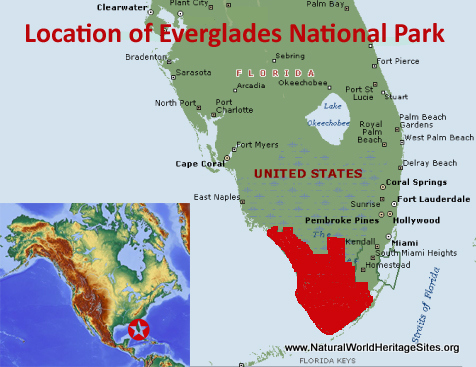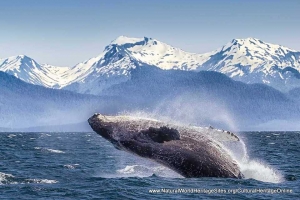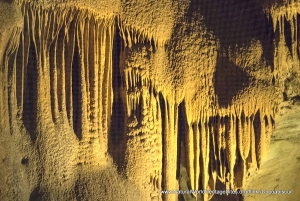EXPLORE Everglades National Park with this slideshow, check the location map and get all the facts and information below.
For slideshow description see right or scroll down (mobile). Click to view slideshow
Location and Values: Everglades National Park protects an extensive wetland in southern Florida, at the interface between temperate and sub-tropical America. It includes the largest mangrove ecosystem in the western hemisphere, and the most extensive stand of flooded sawgrass prairie in North America. It provides the most important breeding ground for wading birds on the continent, supports 400 species of birds and serves as a major corridor for bird migration. Its wildlife includes numerous rare and endangered species, including manatee, Florida panther and snail kite and it is the only place where alligators and crocodiles co-exist in the wild. The Everglades National Park lies at the centre of a protected area complex that includes adjacent federal and state reserves, including Big Cypress National Preserve (2,950 km2), Biscayne National Park (700 km2), Dry Tortugas National Park (243 km2) and the Florida Keys National Marine Sanctuary (9,900 km2).
Conservation Status and Prospects. According to IUCN’s Conservation Outlook Assessment (2020) the conservation status of the Everglades National Park is ‘critical’. The site was first inscribed on the List of World Heritage In Danger in 1993, where it remained until 2007 when it was removed for a brief period before being reinstated on the Danger list in 2010. The main threat to the site is the dramatic reduction in fresh water inflows resulting from drainage and abstraction of water outside the park’s northern boundary. An estimated 60% of previous water inflows has been lost compared with pre-drainage levels and this is having severe detrimental impacts on the vegetation and wildlife. In addition, pollution from agricultural effluents arising outside the park has altered the nutrient balance of the waters affecting the naturally-occurring emergent plants and leading to the proliferation of invasive nutrient-tolerant species. The reduced freshwater inflows have also resulted in increased salinity in Florida Bay, affecting the submerged aquatic vegetation, causing algal blooms and reducing sport fish populations. Invasive exotic species, notably Burmese pythons are further impacting the natural balance of native species, while other problems affecting the site include (1) loss of organic soils due to wildfires and over-drainage, (2) an increase in storm activity due to climate change resulting in excessive impacts on an already strained ecosystem, and (3) interruption of the biogeochemical processes involved in carbonate deposition on the underlying limestone substrate due to ocean acidification. Some progress has been made in restoring previous freshwater inflows, but considerable work remains to be done before the Everglades National Park can be removed from the List of World Heritage In Danger.
Links:
Google Earth
Official UNESCO Site Details
IUCN Conservation Outlook
UNEP-WCMC Site Description
Birdlife IBA
Slideshow description
The slideshow ‘tells the story’ of Everglades National Park starting with a series of aerial photos to illustrate the landscape features of these extensive wetlands, including the interface between mangrove forests and flooded grasslands, and the characteristic channels and bodies of open water. Raised boardwalks provide visitor access in some areas, where birds and other wildlife can be viewed. Photos of some rare and endangered species found in the Everglades National Park include crocodiles, alligators, manatee, Florida panther, and snail kite. The slideshow continues with images of a wide variety of other animals and plants, providing a sense of what visitors to the park can expect to see from the boardwalks or commercial boat trips.
The following individuals, Flickr photographers and other sources are acknowledged with thanks for their contributions to this slideshow: Nick Seymour, Peggy Farren, dconvertini, Judy Gallagher, wlm.org, vacationinflorida.net, nps.gov, wlrn.org, aarp.org, Andy Morffew, Rachel Knickmeyer, psyberartist, USFWS, flicker photos, State Symbols USA, blog.itrip.net, photograpyonthenet, Britannica, Earth Trekkers, evergladeswildlifealliance.org, Diana Robinson, Joe Parks, Nagaranjan Kanna, Stephen Martin, Tony Syvanen, FloridasParadiseCoast, latimes.org, loe.org, USGS.gov, Mens Journal, National Geographic, George Sunker, nfw.org, Pure Vacations.
Factfile
Website Category: Lakes, Freshwater Wetlands & Glaciers
Area: 5,670 km2
Inscribed: 1979
Criteria:
- Geological features (viii);
- Ecological processes (ix);
- Natural habitat for biodiversity (x);
- Significant number of rare, endemic and/or endangered species (x)





